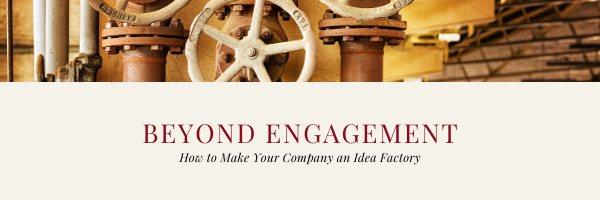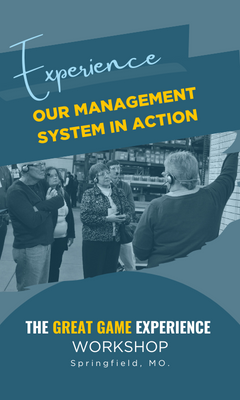
Employee engagement has become a buzzword for business leaders. Everyone wants their business to have it. Yet a 2018 Gallup survey found only one-third of the work force says they feel engaged at work.
Corey Rosen from the National Center for Employee Ownership shares his thoughts on how.
There are lots of articles on how to create an engaged workforce, but in my 40 years of work with the National Center for Employee Ownership (NCEO), I have learned an important lesson. Employee engagement is only the start. Sure, it’s great to have employees who are more careful and work harder. But decades of research—and common sense—says that if you want to be a truly effective company for the long run, you need employees actively identifying problems and new ideas.
Hypertherm, for instance, is a 100% ESOP-owned, 1,400-employee global company that manufactures plasma cutting tools. It has doubled employment in just the last 10 years. Each year, through its team-based employee involvement system, it generates about 2,000 well-developed ideas, of which about 1,500 are implemented. Imagine if in your company, every year, you got at least one good idea, from every employee, that made your company better. How much stronger would your company be?
Hypertherm and the other companies highlighted in this book understand that the key to successful ownership culture is employee involvement. It’s really very simple:
The most effective employee ownership companies are the ones that generate and use the most good ideas from the most people about the most different things that can make the company better.
So how do you get there? That is the topic of a new book I have written for the NCEO, Beyond Engagement: How to Make Your Company into an Idea Factory. It draws on the lessons from dozens of great employee owned companies about how to do this:
Working Harder Is Not Enough
For many companies, there is a base assumption that if you effectively communicate what a good deal the ESOP is, employees will respond with more effort and that will make you more money. While this may be true, it often is true in a relatively inconsequential way.
Let’s assume that your communication program succeeds in getting people more motivated. Now let’s do the math. We want to figure out:
- What percentage of your employees will work harder? If you are a good company already, probably a lot of your workforce is already working as hard as they can, and some smaller percentage is just incorrigibly not so great.
- How much of your costs are affected by extra effort? Many of your costs—taxes, equipment, leases, marketing, R&D, etc., are not affected by how much harder people work.
- How much harder will those who are susceptible to change work? The structure of your work flow may mean that there are not opportunities to do more, but aside from that, can you expect another 15 minutes a day? Thirty minutes?
Say the answer to 1 is 40% (probably a high estimate, but we’ll go with it). The answer to 2 averages about 20% to 35% in most companies. Let’s use 30%. Finally, let’s be wildly optimistic and say you can get another 60 minutes a day out of those whose behavior might change (12.5% of the day).
So:
.4x.3x.125=1.5%
A 1.5% decrease in costs is a good thing, and congratulations for getting there. But new ideas can generate much more profitability with the same effort.
Great Communications on Their Own Won’t Create Great New Ideas
If employees really do understand that their ideas matter, won’t they share them if they know how important they are and how much their ESOP account balances depend on them? Or won’t they just take the initiative and use the new ideas on their own? Some will, but the research and our experience tell us the very large majority won’t.
Open Doors Are Not Enough
Does your company have an “open-door” policy? Chances are it does. In fact, do you know any companies with official “closed-door” policies? The truth is, almost every company says it has an open-door policy. The problem is that not many people walk through that door. Put yourself in the shoes of an employee. Let’s see. Do I leave my machine or my desk to go talk to the boss? Won’t that cause a problem? And if I do go, when? How do I know the boss will be there? What if I go and the boss says “We’ve tried that before”? Or “I’ll get back to you”—but never does? Or takes credit for my idea? Or, even worse, makes a big deal about my idea to my colleagues, who now accuse me of apple polishing?
For all these reasons, open-door policies are very rarely enough to create a genuinely participatory environment in which employees feel not just that they can share ideas and information, but that it is part of their job to do so. The key is not just to allow employee participation, but to structure it into work routines and expect it as part of everyone’s job requirement.
Good Ideas Require Good Information
If you are reading this, you know this. Employee ideas are great, but they shouldn’t be formed in an information vacuum. Employees need to evaluate how their new ideas will affect the critical measurements of performance the ideas are meant to improve. They also need the broader context of how these numbers affect the overall bottom line.
The Key: Move from Permission to Structure
For employees to identify problems and generate ideas, there has to be a structure to do so. The Great Game™ is a brilliant example of this, but there are many other structures companies use. Generating ideas should be seen as a core responsibility of all employees, and creating workable structures a core responsibility of leadership.
Structures involve ways for employees to talk to one another to identify and solve problems, and often to implement solutions. These can include functional teams, ad hoc committees, cross-functional teams, self-managing teams, idea systems processes for sharing ideas remotely, and other approaches.
To make a structured process work, you need to focus on several key principles:
- Identifying problems is more important than identifying solutions.
- Identifying and implementing good solutions depends on using the right metrics.
- Responsibility should be clear. Employees should not face ambiguity about what they are allowed to discuss, resolve, and implement.
- Get the right people on the right teams.
- Create psychological safety.
- Make sure there is time to do this. “Lean” can be great, but if people feel too stressed by other obligations, they won’t take these processes seriously.
Create an Ideas Team
To make this happen, create an ideas team, a group of employees either appointed by management, selected by peers, or both. Give them the task to find a place to start—this will change over time, but you have to start somewhere. They can learn from books, conferences, and visits to other companies. Their job is to identify a few systems they can implement right away, evaluate them over time, and change as needed. This can be a long process, but along the way, a lot of ideas will come up.
An ideas team at employee-owned Barclay Water Management, for instance, brought together people from all departments to consider a new product a salesperson has said a client wanted. A few years later, the new product, IChlor, is a substantial chunk of Barclay sales and a bigger chunk of its profits. This was not an idea from the top-down—in fact, the role of top leadership was mostly to say good work. At employee-owned Paramount Export, the ideas team found that switching from writing checks to using an ACH system saved $10,000 year.
A system for identifying and solving problems at the work level will give your company an edge your competitors will have a hard time matching.
Corey Rosen is the author of the new book Beyond Engagement: How to Make Your Company an Idea Factory. Details can be found here.
Other articles you might like:
.png)







.png)




-5.png)

